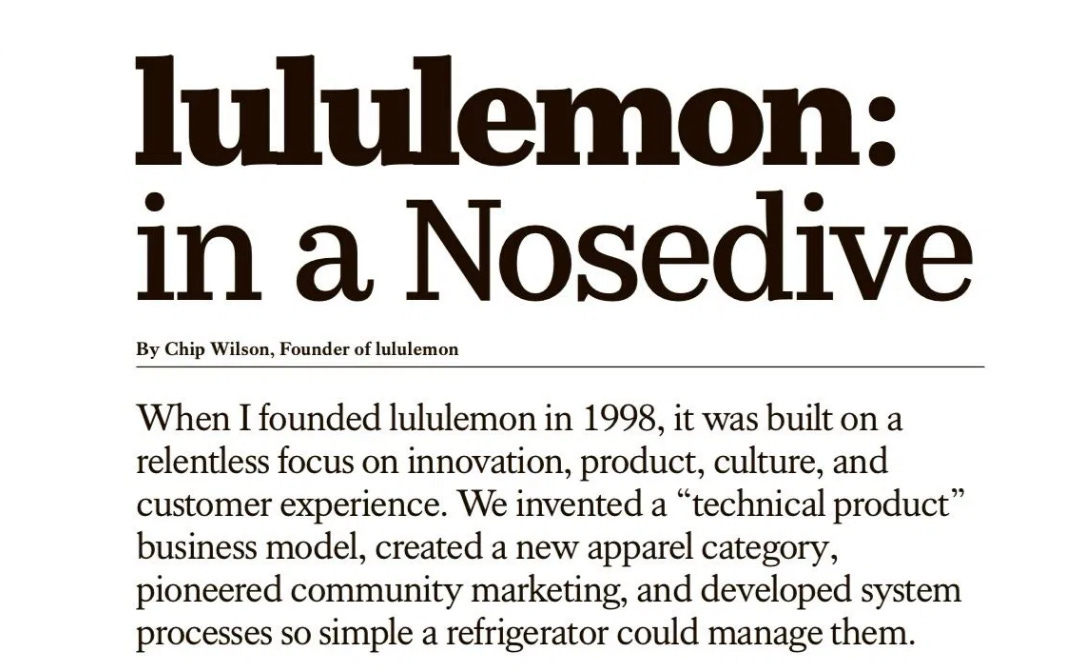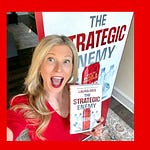Chip Wilson’s full-page Wall Street Journal ad wasn’t just a founder’s rant. It was a positioning SOS that its current leadership should not ignore.
Wilson calls it “GAP-ivization” when a focused, distinctive brand becomes everything to everyone and nothing to anyone.
He is not imagining this.
I was one of the millions of women that felt I was a muse of Lululemon. But if you walk in the store today, it isn’t the same. Loss of focus slowly weakens a brand over time. Death by 1,000 cuts. They need to stop the bleeding and reclaim their anchor.
If Nike’s anchor is running shoes & athletes. Lululemon’s is yoga pants & women.
Lululemon’s response to the ad?
The company dismissed Wilson’s critique as “inaccurate and misleading statements” from someone who “has not been involved with the company for a decade.” And said they remain “confident in their ability to capture meaningful growth opportunities.”
Corporate speak for we got this, what built the brand doesn’t matter.
The Original Enemy
When Lululemon launched, the enemy was crystal clear: frumpy, unstylish athletic wear that made women invisible. Lululemon said no to that. They created technical athletic wear that was fashion-forward, premium-priced, and unapologetically for yoga-obsessed women who cared about how they looked.
That narrow focus was their power. Lululemon wasn’t for everyone. It was for her, the woman who’d pay 100 bucks for yoga pants because they made her feel both athletic and attractive. The brand stood for something specific: elevated athleticwear for the female yoga enthusiast.
When Everyone Becomes Your Customer
Then Lululemon started chasing men. Then casual wear. Then running. Then training. Then running shoes. Then everyone, everywhere, doing everything. And then it got even worse…
The $500 Million Mirror Mistake
Not only did they expand the products, they jumped into technology. In 2020, Lululemon spent $500 million to buy Mirror a home fitness device for streaming all types of workouts.
Mirror had nothing to do with Lululemon’s core strength: designing premium yoga apparel for women. It was connected fitness hardware. A different category. A different enemy. A different battle.
The logic is typical corporate line-extension thinking: “Our customers love us. They’ll buy this.” But that’s not how brands are built. That’s how brands are destroyed.
By 2024, Mirror was discontinued and a half-billion-dollar write-off.
The Disney Debacle
Wilson also called out Lululemon’s Disney collaboration as “wildly inappropriate” and “a desperate move for growth.” He was right. What does Disney have to do with yoga? With premium athletic wear? With the woman who inspires culture?
Nothing.
Reclaiming the Anchor
They need to refocus. Not on “meaningful growth opportunities” but on being the best at one thing again.
The problem is that while Lululemon was expanding, two new focused competitors planted stakes.
ALO is the brand the doubled down on women and yoga. And Vuori entered as a brand for both men and women with a laid-back leisure style focused on durability and comfort.
It’s not easy to grow a brand and maintain focus. It is a delicate balance. What will keep you steady is to remember the brand’s position and anchor in the mind.
Then never forget one of the best ways to grow and protect your company’s future is to give birth to your own enemy.
Chip described Lululemon’s problem as GAP-ivization. Maybe you remember, maybe you don’t. So let’s take a look back as the rise and fall of the Gap and how Old Navy saved the day in this special excerpt from The Strategic Enemy.
From Chapter 11 “Giving Birth to Your Own Enemy”
Gap Gives Birth to Old Navy
The Gap was founded in 1969 by Don Fisher and his wife Doris with a simple idea: make it easier to find a pair of jeans that fit. As the story goes, Don ordered a pair of Levi’s in the wrong size and couldn’t find a local store to exchange them at. So, he opened his own store in San Francisco, in the mist of the hippie movement, and sold wide range of Levi’s jeans alongside records and tapes. Don wanted to call it “Pants and Discs,” but his wife came up with a better name: “The Gap,” shorthand for “generation gap.”
The brand capitalized on the rise of denim as the go-to look for a generation of young Americans and then expanded into other basics such as khakis, T-shirts, and hoodies. Under the masterful leadership of Mickey Drexler, who joined in 1983, the brand became an American icon.
By 1990, Gap sales were just shy of $2 billion and there were 1,092 Gap brand stores. Drexler dropped the Levi’s brand in 1991 to focus exclusively on Gap denim, further cementing the brand.
In 1992, supermodels wearing Gap white denim jeans and white shirts graced the cover of Vogue magazine’s 100th anniversary issue.
The Gap brand symbolized cool and casual style. “As ubiquitous as McDonald’s, as centrally managed as the former Soviet Union and as American as Mickey Mouse, the Gap Inc. has you covered, from the cradle to the grave,” the New York Times said in 1992.
The brand won over everyone from moms to office workers to celebrities like Sharon Stone, who wore a black Valentino skirt and a $26 mock Gap turtleneck to the Academy Awards in 1996.
It was at the height of this success that Drexler launched a new brand, Old Navy. A brand that would one day overtake the original.
Old Navy Was Almost Gap Warehouse
Drexler’s concept was to launch a value brand that was focused on affordable fashion for everyone. The prototype name for the store was “Gap Warehouse.” It was a name many companies would have used, attempting to capitalize on the strength of the original. But they didn’t. Two individuals brands, each with their own identity and focus, was better.
If they had called it Gap Warehouse, initially it would have been fine, and customers would go there to get Gap clothes at cheaper prices. But long-term they would have given birth to their own worst enemy. The Gap would suffer for not being affordable, and the Gap Warehouse would suffer as being seen as not as good as the original. Not only that, how could each have a distinctive identity when they used the same name? They couldn’t.
Instead, they gave birth to new brand, Old Navy in 1994. This new brand pioneered the idea that fashion didn’t have to be just for rich people; it could be for everyone. Within four years, Old Navy reached $1 billion in sales, the fastest brand ever to do so.
By 2000, Gap Inc. had three strong brands and achieved its highest market capitalization at $43.4 billion. The store count was 2,548 for Gap, 666 for Old Navy, and 402 for Banana Republic.
The numbers don’t tell the whole story; while Old Navy was smaller, it was the future. It was the dawn of affordable fashion, and Old Navy was leading the way as new competitors such as Zara and H&M were entering the market. Gap launching a second brand early positioned the overall company for success.
In 2005, Old Navy overtook the Gap with $6.9 billion in sales. (Gap was $6.8 billion.) Since then, while the Gap was losing focus, Old Navy has been Gap Inc.’s golden child and top-performing brand.
In 2024, Gap Inc. sales were $15.1 billion. Old Navy was $8.4 billion. Gap was $3.3 billion. Banana Republic was $1.9 billion. Athleta was $1.4 billion.
The Fall and Potential Rise of the Gap
Launching Old Navy saved the company. But what about the Gap? The ship needed a strong leader at the helm—one that could keep the brand anchored.
In the 2000s, Gap, spooked by the rise of fast fashion, started churning out trendy clothing instead of the classics it was known for. Drexler left the Gap in 2002. News articles on his departure cited “hip-huggers” and “orchid leather pants and crocheted halter tops” as examples of the Gap’s misguided failures.
Gap became stale with always-on-sale apparel. Too many stores, too much merchandise, and a lack of cohesive vision sent them into decline.
In a world of fast fashion, they lost their identity. But it wasn’t all bad; they still had Old Navy. If anyone is going to overtake some of your market share, it might as well be you.
There is hope for a turnaround for the Gap. New leadership is intent on refocusing and reinvigorating the brand. In 2024, they installed fashion designer Zac Posen as creative director. When asked how Gap could reinvent itself, he answered, “You go back to what you do best.”
Posen brings much needed attention, but he has also delivered a much-needed focused approach. While his 53-piece collection of new Gap classics is great, the attention has been much narrower and focused on two key pieces: the white shirt and baggy jeans.
First came the so-called Anne Hathaway white shirt dress, a reinvented take on Gap’s iconic white shirt. Zac designed it for Hathaway to wear at a Bulgari event in Rome, and then Gap released a $158 version of the dress that sold out in less than three hours.
Next came a renewed focus on jeans. Gap showcased its fall denim collection with the help of Australian Grammy Award–nominated artist Troye Sivan, called “Get Loose” to promote Gap’s new baggy and loose-fit denim. It put a modern spin on the marketing approach that made the brand a 1990s wardrobe staple.
To read more check out The Strategic Enemy.












